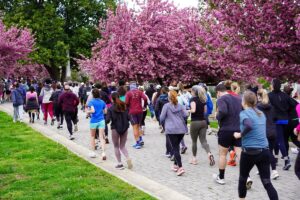
Runners have heard it thousands of times: They need carbohydrates and lots of them. It was common to see runners gobbling down bowls upon bowls of starchy pastas and eating tons of bananas.
But this and other conventional sports nutrition knowledge is being questioned as the scientific field of nutrition grows.
Many runners have taken it upon themselves to buck conventional dietary knowledge and experiment with a diet that is tailored to them. For some, it means eschewing meat and loading up on plant-based proteins. For others, it means making a deep switch and relying on healthy fats for energy. Ditching grains has become popular, too.
From paleo to veganism, specialty diets have become popular for runners as tools of weight loss, health advancement or as a performance boost, but like running shoes, it is not a one-size-fits-all approach.
“The type of diet,” Stacy Peterson said, “plus the time of activity — half marathon or marathon — plus the gender of the person, all affect the outcome of performance. We can’t apply a single diet to all athletes and expect good results.”
Customization is important and looking at the individual, as a whole is important, Peterson, a functional nutritionist and sports performance coach, said.
Whole30, a popular elimination diet, often spikes in popularity at the beginning of the year. The premise is simple: For 30 days remove soy, gluten, dairy, wheat, sugars, legumes, grains and alcohol, and instead rely heavily on animal proteins, healthy fats and vegetables. It’s considered a strict “paleo” diet, a moniker dubbed from how our ancestors may have eaten. The creators meant for the diet to be a tool to test food sensitivities and rebuild a relationship with food. Rapid weight loss is often a side effect.
“I try to do Whole30 during an off-cycle period or just at the beginning of training,” Alison Sremack said. “But, I cannot do it later during a training cycle just because I notice a performance drop with my speed and endurance.”
Sremack has done many rounds of Whole30 as a way to keep her seasonal allergies in check. She’s also noticed a reduction in her inflammation and gets fewer colds after boosting her system with an elimination diet.
Elimination diets taught her she thrives on rice and oats, but wheat and dairy bring about negative reactions. “In my body, there is no substitute for fast-acting carbs,” Sremack said.
To find if a certain dietary style is right for you, health and run coach Kathy Pugh suggests experimentation. While it may be hard to omit and add foods during training, she suggests waiting until a “lower mileage cycle.”
“Take out the high allergen foods like dairy, wheat products, gluten, alcohol and processed sugars for a month, and bring those slowly back in,” Pugh said. Poor digestion, acne, skin irritation, lethargy, bloat or brain fog are all common symptoms or an intolerance.
Those running on a higher fat diet are known as HFLC–high fat, low carb. Healthy fats like olive oil, coconut oil, full-fat dairy, nuts, coconut and avocado are heavily prominent. They get carbohydrates from low-starch vegetables and don’t eat much fruit or potatoes and stay away from grains.
Vegans, like decorated ultra-runner Scott Jurek, stay away from all animal products, including honey. Vegetarians eat eggs, dairy and some eat fish, which would consider them as pescatarians.
The body has three energy systems, each with their own purpose. Runners primarily stick to using the aerobic system, an energy system fueled on carbs and fat that provides lasting energy for endurance activities.
For short bursts of strength of speed lasting no more than 10 seconds, the phosphagen system provides energy through adenosine triphosphate (ATP) that is already in the body. ATP is the biochemical way to use and story energy. Higher intensity exercise like pool intervals, speed work or intense gym workouts, relies upon the anaerobic system, which is fueled only by carbs.
“Knowing those systems, helps us decide how we’re going to fuel,” Lauren Trocchio, registered dietitian said. “Runners do a lot of aerobic work, but there is some anaerobic too, whether it be part of training, up a hill, or a sprint finish in a race. They’re usually using a combination of these systems.”
Fat burners are a puzzler to Trocchio. Humans can become fat adapted, where they use more fat as energy. They’re still in the aerobic zone though, Trocchio said. “If you’re depleted of carb storage, then you’re basically limiting yourself to a certain output. Your speed is going to be someone limited.”
Runners seeking to perform at a higher intensity will need those carbohydrate sources, Trocchio said, but she’ll admit there are outliers who can perform very well on a high carb or high fat diet.
And while yes, the diet does boast fat burning, it is not how runners shed body fat. Fat-adapted athletes tap the fat stores in their muscles, not body fat.
“We don’t lose body fat by necessarily burning it during a workout,” Trocchio said. “We lose body fat by using excess calories in general. Whether it’s carbs or fat, you will lose the weight.”
Six-foot-seven runner Jaco Botes of Arlington is a big guy and during a marathon, he said, he can easily burn 6,000 calories.
“There is just no amount of food or nutrition that you can take on course that would help me,” Botes said. Following the studies of professor Tim Noakes, author of Lore of Running and Real Meal Revolution, Botes began to follow the low-carb, high-fat diet, known as the Banting Diet.
“I did not lose much weight, but I did lose body fat and gained muscle as I continued my workouts and kept at it. The first 21 days were rough,” Botes admits.
As he transitioned, performance for Botes felt slow and higher intensity workouts were tough. Now, he said, he feels as though he can run forever. He doesn’t carb load prior to long runs or races. On long runs, he may munch on avocado or almonds, and during marathons, he often only takes salt tablets. During ultra runs, he may only take some quick carb sources like dates or salted potatoes.
“There are some unexpected benefits of the lifestyle,” he said. “I sleep like a baby. I have no allergies and high energy. I have a positive mindset and improved complexion. And, I feel jet lag effects a lot less. I travel some for work and try to run marathons in cool places around the world.”
Recent Stories
Looking for our race calendar? Click here Submit races here or shop local for running gear
Cherry Blossom 5K 2025 at Congressional Cemetery
Every spring, Congressional Cemetery blooms with new life as we welcome the reawakening of our environmental treasures, including several species of DC’s iconic cherry blossom trees! These beautiful spring hallmarks punctuate every spring in DC with their stunning beauty. While
The Hunter Exam
The Hunter Exam is a unique elimination style fitness event, where finalists earn a coveted “hunter license”. This license not only comes with prestige, but access to future events, perks under The Hunters Association, and private access to the pro






